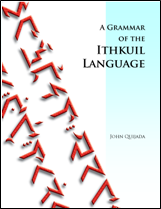

Update: The Ithkuil Grammar Is Now Available in Book Form!
This website presents a comprehensive grammar of a constructed human language, Ithkuil. The original version of the language was posted to the Internet in January 2004. A variation on the language called Ilaksh, designed for easier pronunciation was posted in June 2007. These two versions of the language have now been replaced by a new, definitive (and final) version of the language as of July 2011.
For those familiar with the history of artificial language construction, Ithkuil represents a cross between an a priori philosophical language and a logical language. It is by no means intended to function as a “natural” human language. Ithkuil exists as an exercise in exploring how human languages could function, not how human languages do function.
While I enjoy the idea of inventing fictional languages which mimic natural languages, it is not enough for me to add simply another language to the thousands that already exist or have existed. For me, the greater goal is to attempt the creation of what human beings, left to their own devices, would never create naturally, but rather only by conscious effort — an idealized language whose aim is the highest possible degree of logic, efficiency, detail, and accuracy in cognitive expression via spoken human language, while minimizing the ambiguity, vagueness, illogic, redundancy, polysemy (multiple meanings) and overall arbitrariness that is seemingly ubiquitous in natural human language. This new version of Ithkuil represents the culmination of over thirty years of personal effort toward creating such a language.
Acknowledgements: I wish to thank all of those who have taken an interest in Ithkuil, including Stanislav Kozlovskiy, whose 2004 article “The Speed of Thought” brought Ithkuil to the attention of so many people in the Russian-speaking world. Спасибо, Стас! Thanks also to Lexa Samons for his hard work in translating the original Ithkuil site into Russian and to fellow linguist and conlanger David J. Peterson for bestowing upon Ithkuil the 2008 Smiley Award.
And I am grateful to Dr. Oleg Bakhtiyarov of the University for Effective Development in Kyiv, Ukraine for his interest in my work and for giving me the opportunity to visit him and his colleagues and students both in Kyiv and in Elista, Kalmykia.
| —John Quijada |
 |
For those who would like a copy of the Ithkuil Grammar And while you’re at it, you can check out the novel I co- (It’s a political thriller/science fiction story that explores the |
©2004-2011 by John Quijada. You may copy or excerpt any portion of the contents of this website for private, individual, or personal use which is non-commercial in nature and not for purposes of profit. Otherwise, you may copy or excerpt brief portions of the contents of this website in published, web-accessible, or commercially distributed articles, papers or webpages for purposes of review, commentary or analysis, provided you give full attribution to the author and this website.